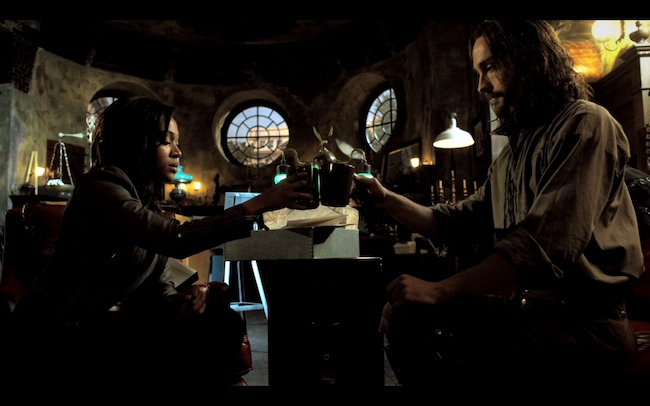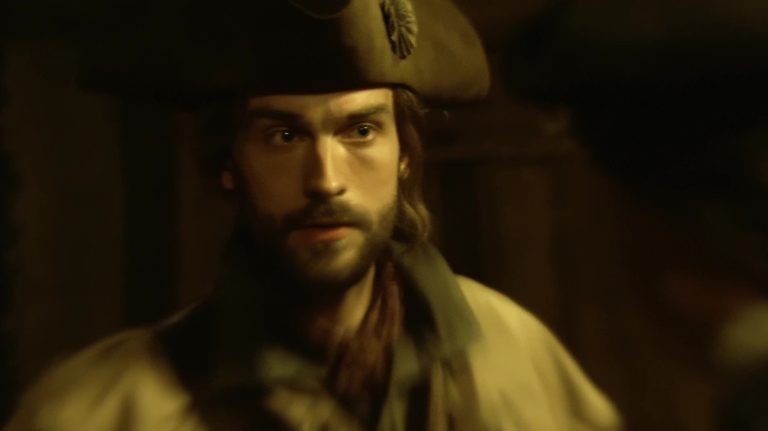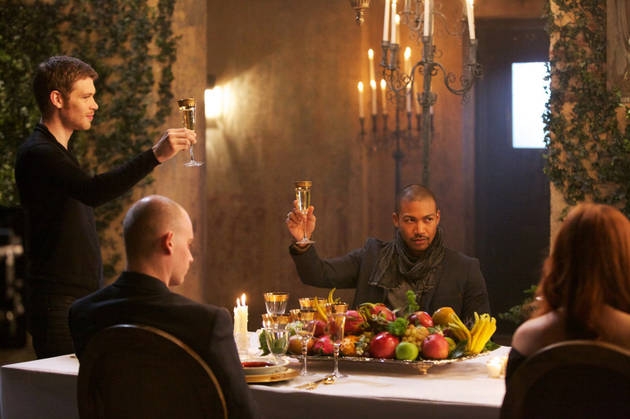
White Collar, how do I love thee? Oh, at least 81 different ways – which is how many episodes this fun, doesn’t-take-itself-too-seriously USA series aired before signing off on December 18th, 2014, with “Au Revoir.” In the end, White Collar stayed true to the very scenario it setup from the outset, Neal is a con man, who can be trusted up to a point, and Peter is an FBI agent, with a willingness to color outside the lines a smidge if it helps a friend.
Sure, when we first met Peter he was a straight-laced FBI agent, but his ease and willingness at bringing Neal on board as his CI and his trust in him within just a couple of episodes led me to believe that he had a streak of unconventionality in him that only needed someone to bring it out. Neal certainly did that. Peter also brought out the best in Neal by giving him a purpose, an identity, a family. Neal had lost all of that through childhood trauma and then when his heroic illusions of his father were destroyed. Losing his identity and his family he lost his purpose, choosing instead to live his life by sipping fine wine, enjoying expensive – and stolen — art, and drinking pricey coffee, all while looking stylish in a suit, tie, and hat.
These two men found a kinship between them, a kinship that at times had Peter doing things decidedly gray, while Neal continued to straddle the line between black and white. It’s hard to tell who changed the most. At times, it seemed like it was Neal who had changed the most. In fact, at the end of Season 3 Neal made it clear that no matter what became of his parole hearing, he would stay in his new life as a CI with the FBI. Things changed however when Kramer from D.C. decided to make a move to keep Neal as his own CI, move him to D.C. and tighten his leash. That betrayal led to Peter doing the most blatantly outside the lines move in the series – and Peter had done some pretty outside the lines moves already – as he tipped Neal off and basically gave his blessing for Neal to run. And run Neal did.

After that, Neal never really wanted anything more than his freedom, on his terms. It was a turning point in the series that heretofore had been pointing Neal more and more to complete redemption, thus justifying some of Peter’s earlier illegalities because the end would justify the means: Neal is redeemed fully. Neal never quite recovered the same equilibrium after that, and his father’s return into his life certainly didn’t help.
Throughout the series Neal has always struggled with identity, is he his father’s son? If so, does that mean he is predestined for a life of crime? Mozzie certainly believed that to be true – not that Neal’s father was the catalyst, but more so that Neal, like Mozzie, was born to live unconventionally, that rules were for other people, that the law was a ruse, and that Mozzie and Neal simply were made to be who they were, conmen, and that they shouldn’t fight it. In the end, Neal didn’t fight it. He had had one betrayal too many. While he certainly trusted Peter, he also knew three very important things with this last adventure: First off, while Peter may have secured Neal a contract, someone could, and likely would, circumvent it; and, two, the Pink Panthers – their most ambitious case ever, would seek revenge and, three, with Keller loose the Burkes would forever be in danger. Thus, Neal needed to tie up as many loose ends as he could to ensure the safety of those he cared about. Staying and honoring his agreement and securing his freedom would have meant that the Panthers could seek revenge on him and Keller could still be a threat to Peter and Elizabeth, so he set the pieces in motion and played his greatest con.
The ending makes it clear, at least to me, for all that things changed over 81 episodes, most things remain very much the same: Neal is who he is, an art thief, and Peter is who he is, an FBI agent. The chase is on. Despite bowing at Episode 81, Neal and Peter, as well as Mozzie, are still out there doing what they do. It never stops moving. And Mozzie – and Willie Garson – did some of their best work in this final episode. As Mozzie broke down over Neal’s ‘dead body’ it was visceral. Garson stripped away all of Mozzie’s veneer and gave us the man inside fully. It was devastatingly gripping. Well done!
White Collar was unique among a crop of USA shows that includes the slick, sophisticated Suits, the over-the-top spy thriller Covert Affairs, the gritty and at times dark Burn Notice, and the straying towards slapstick, but ever appealing Psych. White Collar was fast, slick, over the top, at times repetitive (not in a good way either, but no one is perfect) funny, silly, and yes, constantly moving, much like Neal Caffrey.
The idea of constant motion was so much a part of this show, not only in that we always knew Neal to be working an angle or having an escape plan, but also in how the show was shot. The cinematography was very distinctive. Every shot of the city and its landscape always had motion, whether it was the clouds moving across the sky, the sun rising and setting to show the passage of time, whether it was busses and cars moving or fountains spewing water into the air, people walking…it was perpetual motion, just like Neal. Neal always had a plan, always worked an angle, always planned his moves several steps in advance; when he was at rest, it was a con, for Neal Caffrey was never at rest.

The opening theme was distinctive as well, lending the idea of perpetual motion. The one time Jeff Eastin tried a quieter theme, the fans created such uproar that he actually had an online voting contest. The original theme won overwhelmingly and they never varied it again. (I voted many times for the original them. Hey, it was allowed to multiple vote!)
White Collar’s attraction wasn’t that it was especially deep or that its crimes were especially complex, although at times there were season long arcs and mysteries to keep us hooked. White Collar’s attraction was that it didn’t take itself too seriously, but at the same time gave us serious characters, with real flaws, real sorrows, and real personalities who were searching for real answers. Neal needed to find the woman he loved, and when she was killed, he needed to find her killer. Elizabeth Burke, no wilting lily here, was kidnapped by Keller, and he would most certainly have killed her – after all, he killed Kate, but she managed to free herself (told you, she was no wilting lily) and then encouraged Peter to save Neal. At times the drama was real, at other times it was contrived, no doubt about it. That’s the difficulty with doing a long-running show with a “catch me if you can” attitude: sometimes you go around in circles. Peter would believe Neal had changed, Neal would almost change, and then something happened and distrust would brew and alliances would weaken. It’s just part of the game of shows that go on for a long time. But watching Neal make friends, watching him win over by the book FBI agents, not just Burke, but Clinton Jones (played wonderfully by Sharif Atkins) and Diane Barrigan (played by Marsha Thomason) was equally fun. Over the seasons these agents befriended Neal to a point, and at times even assisted him in his escapes, or found their lives saved by his direct actions. They were explored as well, their loves, their dreams. White Collar included everyone in the mix.
Despite some real consequences, death, prison, unemployment, White Collar never really took itself too seriously. I mean, how serious can the show take itself when in one episode (Countdown) Neal, with Mozzie’s help, breaks into a penthouse, steals back a Degas, and then base jumps from the high rise down to Wall Street, landing fluidly, catching his trademark hat and, with aplomb, places it on his head as he shucks the equipment and hands the painting, neatly rolled and hidden in a canister, to a waiting Mozzie. Really? Yep, on White Collar it’s really. To top it all off, at the end of that season in Judgment Day Peter asks Neal how he managed to pull that off – proving that he wasn’t fooled by Neal’s protestations that he never had the Degas in his possession originally, and Neal, in a moment of absolute honestly, looks Peter square in the eye and details exactly how he pulled it off. For his honesty, he gets a laugh from Peter and a wry, Fine, don’t tell me. It’s a fantastic moment, hilariously funny, and brilliantly acted by both stars. Neal is incredulous and Peter is patiently underwhelmed. It’s also absolutely the epitome of White Collar. Neal’s truths are so fantastic that they must be lies, and Peter is too rooted in black and white to believe some of the more crazy elements around him.
White Collar was a great show filled with rich characters that made me feel at home each episode. Elizabeth Burke was Peter’s understanding, patient wife who was also an accomplished businesswoman herself. She frequently assisted in their adventures, either because of her art knowledge or through her catering and event planning expertise and contacts. She was a sounding board for not only Peter, but for Neal, and she and Mozzie were a delightful odd couple as they bonded over fancy wines, fancy cheeses and traded recipes.

Mozzie, the perfect sidekick was also an accomplished conman with a disdain and outright distrust of the government. Burke was always “Suit” and Elizabeth was “Mrs. Suit.” Mozzie is a gentleman after all. In a pinch he could be counted upon to scare up surveillance equipment, root out bugs and listening devices, and Neal’s wine collection was always in distress with Mozzie around, and Mozzie, well, he had a conspiracy theory for everything, absolutely everything. Even when he felt betrayed by Neal it only took learning that Elizabeth was in danger for Mozzie to come running to help, and run he did, all the way into the dreaded FBI building – Mozzie’s idea of a Death Star, or Mount Doom. Mozzie was a friend through thick and thin, and it was perfect that he stayed in New York City for an entire year to maintain the con before leaving to join Neal in Paris – the mecca for an art thief, and the one place the show had never managed to take Neal throughout its run. It’s Neal and Mozzie’s Grand Canyon (you SPN fans will understand that reference).
I’m sorry to see White Collar go. It was an enjoyable, fluffy, fun adventure every episode. The waits between the first part of the season and the second always seemed so interminable, but when it returned to my screen, I was instantly back with the gang, as if no time had passed. It was also the first of several USA shows that began to capture my attention back in the summer of 2009 – the summer that I lost my beloved German Shepherd Dog. His death was sad, and I was very much alone. That summer I found Psych, and through watching that delightfully ridiculous show (said with great affection) I saw the previews for White Collar. When it debuted in October, I was instantly hooked. For now, USA has no shows that I watch anymore. But, seasons come and seasons go, and shows on TV certainly cycle around. TNT, A&E, and USA were my go-to channels for hiatus, and now, more and more, they are not. That’s all right. I have DVDs to keep me warm on the long winter nights, and Peter and Neal will continue to grace my screen. And, in my mind, they are still off having adventures and the chase is on across the globe. It was the perfect ending – even as I read Jeff Eastin’s account of his intended ending, which would have been excellent as well. In the end though, he chose to follow the ending his two stars proposed, and I think it honors the show and the characters perfectly.

Farewell, White Collar – or perhaps more accurately: Au Revoir!
As always, thanks for reading, Elle2





Elle2,
I was actually disappointed in how the series ended. I was really hoping that Neal got his clemency, went to work for the FBI in the White Collar division and lived his life doing what he loved without the fear of beig chased by law enforcement. The retribution threat from the Pink Panthers made that impossible, but that detail didn’t have to be added by the writers. Yes, the characters stayed true to their identities, but doesn’t that basically say that all those years with each other didn’t fundamentally “save” Neal? He is no better off than he was before this long journey (well, he has $23million, so I guess that’s something!). He has a beter knowledge of himself but is he going back to stealing? Did you get the impression from the Louvre article that he was going to steal and now be hunted by Interpol? Did you also interpret that the playing card meant that Mozzie was going to meet him? If so, when did Mozzie learn that Neal was alive?
Was it ratings that forced the show to end or was it the actors (I don’t read up on this show very much). I have loved this show from the beginning (it was probably my 2nd favorite show) and am very sorry to see it end.
Hi, Nightsky,
I think White Collar ended (too soon, even if it was repetitive at time, as I said) for a couple of reasons, one of which I do think is ratings. However, Jeff Eastin also runs the dark, gritty (and I find completely unappealing) Graceland, and he needs time to focus there. Last season White Collar’s episode order was trimmed from 16 to 13 expressly so Eastin could focus on Graceland. Pity too, as his split focus showed in the lack of quality in White Collar last season.
To me, the show hit its high at the end of Season 3 (Judgment Day) and never really recovered from there. Having Neal skip with Mozzie to a remote island and then having Peter bring him back with a huge prize in tow (a wanted criminal) and giving the victory to Kramer as a ‘bribe’ to leave Neal alone was very much a jump the shark moment…and yes, they came back down too, Mr. Kripke!
I would have liked Neal to achieve clemency and work for the FBI, but unfortunately, that ship sailed at the end of Season 3. As I said, Neal never quite recovered from that and more and more was always working a side angle. I think Neal steals art more for the challenge, the fun, he just can’t help himself but have a game, with anyone. And, yes, Eastin made it clear in an interview that Mozzie knew Neal was alive, and went to join him in Paris. Mozzie was in on the con with Neal all along. At some point, unseen by us, Neal filled Mozzie in. Mozzie stayed behind to sell the ruse, giving Neal time to set up shop in Paris, or wherever he was for that year. When Mozzie left Mozart behind for baby Neal, it was his way of saying good bye. Neal sent the wine to Peter to tip him to the storage shed and Peter figured it all out. Eastin made it clear the intent is that Peter is chasing Neal.
His original ending, which would have been truly fabulous (but I respect that his two stars, who do know the characters better than anyone after having portrayed them for 81 episodes) proposed the idea we saw, and Eastin honored their wishes. Eastin’s original idea (and the one he sold the network originally when he pitched the series) was that the final scene would be Neal walking down the NYC street, stopping at an intersection and flipping a coin, then he would turn one direction and walk, we would see a period of time pass and Neal would be stealing art and living the life of a conman. Then, the scene would flip back to Neal at that same intersection flipping a coin and he would turn and walk in the other direction, time would pass and we would see him years later (like 5 years I think) running the White Collar division with Peter promoted and in D.C. or something. Then the scene would shift back to Neal at that intersection flipping that coin and the screen would go black. We each could decide what he was doing. So, if you prefer, you can mentally go with that idea.
For me, I think Neal realized he has good inside him, he stayed away from killing, he helped people get back their art, he even made sure stolen art that was hoarded by a museum was returned to its rightful owner, and shut the snotty museum curator up to boot. He made friends, he settled into a life, as much as he could, but his talk with Elizabeth was telling: she trusted him to a point. And I think Neal realized that he was a good person…to a point. He would save and protect Peter, and he did, but he just couldn’t go the straight and narrow…he just couldn’t. Also, it’s brave, like it or not, the show picked an ending that does keep the adventures alive, as well as leaves the opportunity for a special movie event. Who knows what will happen.
Anyway, that’s my thoughts. I liked it. I think it ended well. Actually, Burn Notice and Psych also ended very well. Psych similarly has the gang off doing their same shenanigans, only now in San Francisco and Burn Notice, well, that was darker and sadder, but also very true to the series … and, oh, Maddie! That hurt. That really, really hurt.